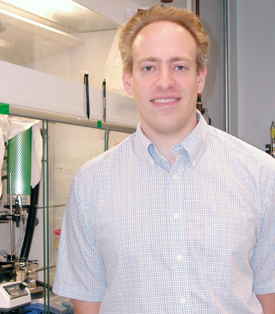Lin Asks Why: Interview With Dan Appella
A Small-Molecule Drug to Kill HIV: An Interview with Dan Appella
Dan Appella leads the Synthetic Bioactive Molecules Section in the Laboratory of Bioorganic Chemistry in the National Institute of Diabetes and Digestive and Kidney Diseases. He works collaboratively with NIH researchers on a variety of projects including the design of a small molecule that kills human immunodeficiency virus (HIV). Dan sat down over lunch one recent afternoon with inquisitive five-year-old NIH Catalyst intern Lin Wanjek-Yasutake, who cut to the chase with a set of hard-hitting questions.

PHOTO BY: BELLE WARING
NIH chemist Dan Appella (NIDDK)
Lin: What are you doing?
Dan: I’m making molecules.
Lin: Why?
Dan: Well, if we know how some of these molecules affect biology, we can use them to help people who are sick.
Lin: Why?
Dan: Because people who are sick want to feel better. For example, one of the projects I’m working on is to make a new medicine for HIV that we think won’t create new resistant viruses. It’s a very simple molecule, which I think is nice.
Lin: Why?
Dan: With a simple molecule—very easy to make, two steps done in one pot—we can more easily study the biology to make sure it works well and that it’s safe in a variety of animal models. What’s most interesting is that the molecule attacks the virus through a different mechanism than what most people think about. There’s great potential here.
Lin: Why?
Dan: Well, most of the drugs stop the virus from working by attacking protease or integrase or reverse transcriptase. But we are trying to target a nucleocapsid protein, which has been attacked before but by molecules that are not as good. We have molecules now that are a lot better than what were studied in the mid- to late-1990s. And so far, our molecule seems to be nontoxic. The key difference is that our drug modifies the protein permanently so it can never work again.
Lin: Why?
Dan: Because a transfer of an acyl group from our molecule to this nucleocapsid protein makes it fall apart. This is quite different from how a lot of drug development works today. Most people want noncovalent binders.
Lin: Why?
Dan: Binders are very sticky. They gum up a virus. For a long time, drug companies have been trying to get away from covalent-modifying drugs because many are toxic. But now there’s interest in re-examining some of these things. Look at aspirin—it covalently modifies lots of things. We are still trying to figure out our molecule, but we believe it has features that give it good specificity to the HIV target.
Lin: Why?
Dan: The guiding principle is the HIV target itself; it’s a unique structure that is very different from what you would see in a healthy human being. The proof, of course, is in the final experiments so we continue to study this.
Lin: Why?
Dan: The payoff would be huge. This is a collaborative project with several NIH investigators. In fact, I’m working on this, in part, with my dad, who…
Lin: My dad?
Dan: No, my dad [Ettore Appella]. I think your dad [Christopher Wanjek] is a writer. My dad is a researcher at the National Cancer Institute and has been studying the approach for years. I’ve come in as the chemist to help move the project forward. We published a paper about the mechanism of this molecule in Nature Chemical Biology in 2010 [Nat Chem Biol 6:887–889, 2010]. The mechanism is interesting—instead of one molecule taking out one target, ours does one covalent transfer, and then the cells reactivate it to its active form again. So you have this catalytic turnover that attacks the HIV target. We are hoping we can pick up on that aspect of this molecule.
Lin: Why?
Dan: This recycling aspect is very intriguing. The molecule keeps on going to kill all the viruses. Also, it’s my gut instinct that, to clear the virus, you will have to have something very small that circulates extensively through the body. It’s clear that the HIV virus hides very, very well. A small molecule could permeate every hiding place where this virus could be.
Lin: Why?
Dan: Well, precisely because it is small. The molecule itself would find the nucleocapsid protein in an infected cell, knock it out, and prevent the virus from maturing. Now, if I can anticipate your next question, let me repeat that there’s a transfer of an acyl group from our molecule to the protein target. That transfer results in an unfolding of this protein. Its actual place on the protein is a zinc finger. There’s a zinc atom in the middle, and it’s coordinated by amino acids, like a loop. Upon our molecule’s transfer to the finger, the zinc falls out, the protein falls apart, and it can no longer bind HIV RNA and further maturation.
Lin: Why?
Dan: Well, the interesting thing is that the virus still buds off the infected cell, but it no longer works. We are messing up the maturation of the virus in a way that’s similar to protease inhibitors.
Lin: Why?
Dan: Protease inhibitors prevent the protease enzyme from making maturation-essential cleavages in the proteins made by virus. There’s a similarity between the actions of our molecule and protease inhibitors, but some strains of HIV have become resistant to protease inhibitors. Our molecule may be able to avoid the resistance problem. But with any drug development, you want to know, what’s the likelihood this molecule will become a drug? The odds are against us. This is a high-risk, high-reward project.
Lin: Why?
Dan: It will take a long time to prove whether our molecule is beneficial, and there’s a chance that it won’t be. But, from my standpoint, this is an overlooked area of drug development. What I like the best is that our molecule can knock out more than one target. Our serendipitous discovery is interesting for future drug-design studies even if it turns out that our molecule isn’t great for HIV. Perhaps the recycling and reactivation mechanisms can be translated to other therapies. I don’t know of anything else like this in drug development.
Lin: Why?
Dan: Good question. That’s what I’m wondering. Note, of course, there could be something we overlooked. The field of medicine is huge. There is this idea of pro-drugs—something that gets activated by the body and attacks the target. But our molecule, once it gets going, keeps reactivating itself. So, in light of all of this, I hope you can understand the potential of our drug.
Lin: OK. Bye.
Dan: Wait! Don’t forget your stuffed kitty.
Lin: Oh, thanks!

PHOTO BY: CHRISTOPHER WANJEK
Lin Wanjek-Yasutake
EDITOR’S NOTE: DO YOU HAVE A HIGH-RISK, HIGH-REWARD PROJECT TO RELAY? CONTACT US AND WE’LL SEND LIN TO GRILL YOU ON THE DETAILS.
This page was last updated on Friday, April 29, 2022
